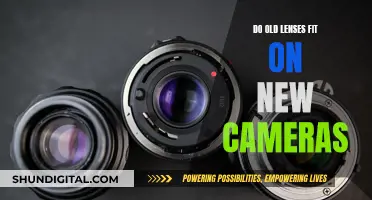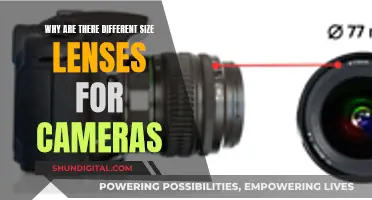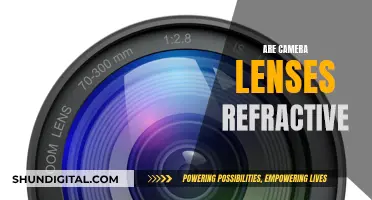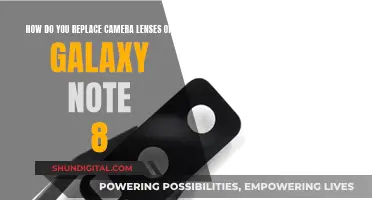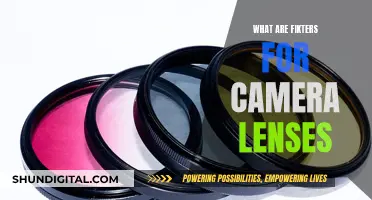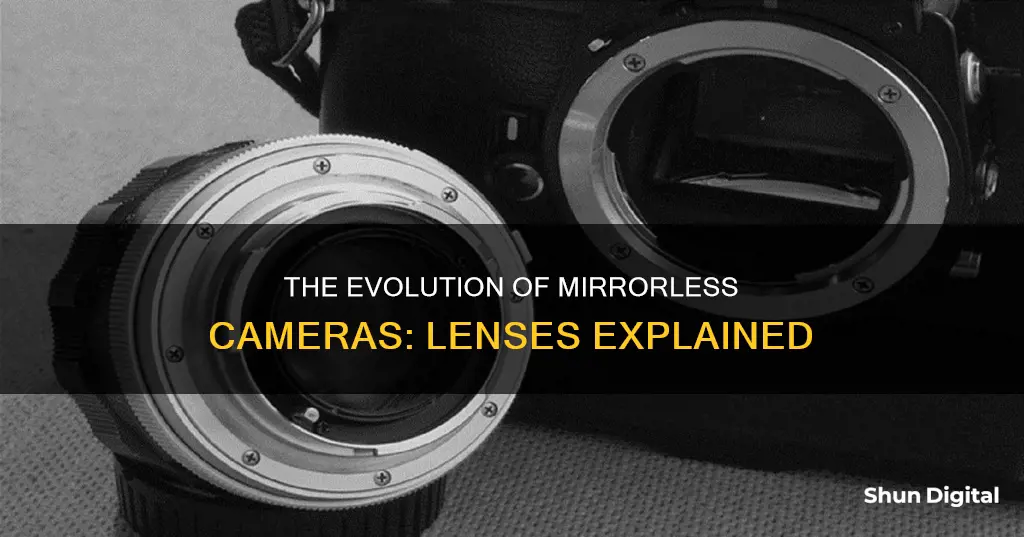
Mirrorless cameras use different lenses compared to DSLRs. This is because every lens focuses light a certain distance behind it, and the camera/lens are designed so that the sensor is right at that point. In a DSLR camera, the mirror is between the sensor and the back of the lens, so the lenses are designed to focus the light further back. However, in a mirrorless camera, there is no mirror, so the light can be focused at a much shorter distance, making the camera body shorter. This is why you can adapt DSLR lenses to mirrorless cameras but not the other way around.
What You'll Learn

Mirrorless cameras can use DSLR lenses with an adapter
Mirrorless cameras have been on the market for over a decade, but they have become increasingly popular in recent years. One of the main reasons for their popularity is their compact size and lightweight design, making them ideal for travel and street photography. Another advantage of mirrorless cameras is their interchangeable lenses, which offer greater flexibility and control over selective focus and depth of field techniques.
When it comes to using DSLR lenses with mirrorless cameras, it is indeed possible to do so with the help of an adapter. DSLR lenses are designed specifically for DSLR cameras, but many of them can be adapted for use on mirrorless cameras as well. This is especially useful if you already have a collection of DSLR lenses that you want to continue using.
Canon users can attach their DSLR lenses to their mirrorless camera using the EF to RF adapter. This adapter is compatible with both Canon and third-party lenses, such as those from Tamron. Similarly, Nikon users can utilise the FTZ (F-mount to Z-mount) adapter to mount their DSLR lenses onto Nikon mirrorless cameras. Sony also offers the A-mount to E-mount adapter, allowing photographers to use their older Sony DSLR lenses on their Sony mirrorless cameras.
While using adapters can be a cost-effective way to transition to mirrorless cameras, it is important to note that not all DSLR lenses will work flawlessly with mirrorless cameras. Some features, such as autofocus and EXIF information, may be missing when using DSLR lenses with mirrorless cameras. Additionally, older DSLR lenses may require manual focus or aperture adjustments. Therefore, it is advisable to research the compatibility of specific lenses before making any purchases.
In summary, while mirrorless cameras typically have their own dedicated lenses, it is possible to use DSLR lenses with an adapter. This can be a convenient and economical option, especially for photographers who already own a collection of DSLR lenses. However, it is important to consider the potential limitations and ensure compatibility before making the switch.
Finding the Right Camera Body for Your EF-M Lenses
You may want to see also

Some features may be lost when using an adapter
When using an adapter to attach a lens from a DSLR camera to a mirrorless camera, you may encounter some issues with certain features. While the adapter allows for physical attachment, some automatic features may not work as expected or may be slower. This includes autofocus, which may be missing or less reliable. Additionally, you may be restricted to certain exposure modes and features on the camera, such as being limited to manual exposure mode.
Some older lenses may also lack automatic aperture control, resulting in the unavailability of electronic metering, automatic exposure modes, and EXIF data. It is important to note that not all adapters are created equal, and cheaper adapters may only provide manual control. They can also affect the performance of certain features, such as image stabilization.
Another consideration is the physical size and weight added by the adapter. This can defeat the purpose of using a smaller, lighter mirrorless camera setup. Adapters also add to the overall length of the lens, which can make the setup bulkier and more cumbersome to use.
Furthermore, when mixing brands of cameras and lenses, compatibility issues may arise. For example, using a Nikon DSLR lens on a Canon mirrorless camera may require a costly adapter and may only provide a fully manual experience. It is important to research the specific trade-offs and compatibility of the lens, camera, and adapter before committing to a new setup.
The Grey Market: Camera Lenses Explained
You may want to see also

Third-party manufacturers produce compatible lenses
For example, Canon DSLR lenses can be adapted to Canon mirrorless cameras using the EF to RF adapter, and Nikon DSLR lenses can be adapted to Nikon mirrorless cameras using the FTZ (F-mount to Z-mount) adapter. Sony also offers a DSLR-to-mirrorless adapter, the A-mount to E-mount adapter, allowing users to utilise older Sony DSLR lenses on their Sony mirrorless camera.
It is important to note that while these adapters enable the use of DSLR lenses on mirrorless cameras, the reverse is not true. Mirrorless lenses cannot be adapted to DSLR cameras due to the shorter distance between the lens and the sensor in mirrorless cameras. Additionally, some features, such as autofocus and EXIF information, may not be available when using adapted DSLR lenses on mirrorless cameras.
When choosing a third-party lens, it is advisable to research its compatibility with your specific mirrorless camera model, as not all lenses will work flawlessly with every camera.
Camera Lenses: Yardage Vision Range Explored
You may want to see also

Mirrorless cameras have interchangeable lenses
The ability to swap out lenses is a significant advantage, especially for those who have never used an interchangeable lens camera before. It can transform your photography by allowing you to capture a wider range of shots and experiment with different styles.
For example, you can attach a long zoom lens with an f/2.8 aperture or a prime portrait lens with an f/1.4 aperture. These lenses give you more control over selective focus and shallow depth-of-field techniques, enabling you to create images with a pronounced bokeh effect.
Additionally, mirrorless cameras usually have a shorter focal flange distance (the distance between the lens mount and the sensor). This means that, with the right adapter, you can often use lenses from other camera systems, such as DSLR lenses, further increasing your lens options.
However, it's important to note that using adapters may result in the loss of certain features, such as autofocus and automatic exposure modes. It's also worth considering that the lenses designed for DSLRs may be much larger and bulkier than the mirrorless camera body, affecting the balance and portability of the setup.
Overall, the ability to interchange lenses on a mirrorless camera greatly enhances its capabilities and gives photographers the freedom to explore different types of photography.
The Intriguing Pricing of Camera Lenses: Factors and Features
You may want to see also

There are many types of lenses for mirrorless cameras
Within these two categories, there are several types of lenses available with different focal lengths.
Macro Lenses
Macro lenses allow for close-up macro photography, capturing exceptional detail at very close range.
Telephoto Lenses
Telephoto lenses are zoom lenses with varying focal points, allowing you to isolate distant subjects.
Wide-Angle Lenses
Wide-angle lenses help you fit a large area into your frame, making them ideal for landscape or street photography.
Standard Lenses
Standard lenses are versatile and can be used in different types of photography.
Specialty Lenses
Specialised camera lenses give your photos a unique look. Examples include fisheye, tilt-shift, and infrared lenses.
Super Wide Zoom and Super Wide Prime Lenses
Super wide-angle lenses are great for architecture and landscape photography, allowing photographers to capture as much of a scene as possible.
Full-Range Zoom Lenses
Full-range zoom lenses cover almost all focal length ranges, from wide-angle to telephoto or even super telephoto views.
Super Telephoto Zoom and Prime Lenses
Super telephoto lenses are popular for sports, wildlife, and astrophotography, as they can zoom in on objects that are very far away.
Additionally, lenses can be categorised by the camera brand they are designed for, such as Canon, Nikon, Sony, Fujifilm, Olympus, and Panasonic Lumix.
When choosing a lens, it is important to consider factors such as size, weight, features, and compatibility with your camera body.
Choosing Camera Lenses: A Guide to Shopping for Beginners
You may want to see also
Frequently asked questions
Yes, it is possible to use DSLR lenses with a mirrorless camera, but an adapter may be required. Some camera manufacturers provide adapters for lenses outside their own, and third-party manufacturers also produce adapters. However, automatic features may not work as reliably, and the setup may be bulkier than intended.
Mirrorless lenses are not compatible with DSLR cameras. The mirrorless lenses would be too far away from the sensor in a DSLR, and there is no space to add an adapter to bridge the gap.
Mirrorless lenses offer several advantages. The rear lens elements are closer to the sensor, allowing for faster and more compact lenses. The autofocus is also typically faster and more precise. Additionally, mirrorless cameras utilise interchangeable lenses, providing more flexibility to photographers.
One potential drawback is the need for adapters when using DSLR lenses. This can affect the overall size and weight of the setup. Additionally, not all features may be supported when using adapters. It is also worth noting that mirrorless lenses are generally more expensive than DSLR lenses.
Nikon offers a range of mirrorless Z-series lenses, including the NIKKOR Z DX 18-140mm f/3.5-6.3 VR lens, which is a versatile all-in-one option with a wide focal length range. Canon's RF-mount lenses and Sony's E-mount lenses are also designed specifically for mirrorless cameras and offer advanced features and improved performance.


